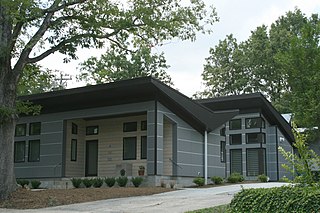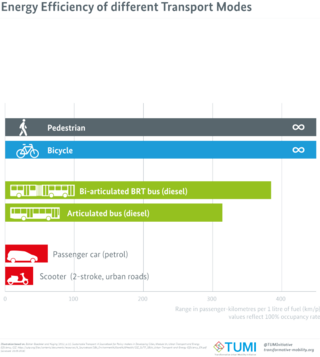
The Natural Resources Defense Council (NRDC) is a United States-based 501(c)(3) non-profit international environmental advocacy group, with its headquarters in New York City and offices in Washington D.C., San Francisco, Los Angeles, Chicago, Bozeman, India, and Beijing. The group was founded in 1970 in opposition to a hydro-electric power power plant in New York.

Green building refers to both a structure and the application of processes that are environmentally responsible and resource-efficient throughout a building's life-cycle: from planning to design, construction, operation, maintenance, renovation, and demolition. This requires close cooperation of the contractor, the architects, the engineers, and the client at all project stages. The Green Building practice expands and complements the classical building design concerns of economy, utility, durability, and comfort. Green building also refers to saving resources to the maximum extent, including energy saving, land saving, water saving, material saving, etc., during the whole life cycle of the building, protecting the environment and reducing pollution, providing people with healthy, comfortable and efficient use of space, and being in harmony with nature. Buildings that live in harmony; green building technology focuses on low consumption, high efficiency, economy, environmental protection, integration and optimization.’

Leadership in Energy and Environmental Design (LEED) is a green building certification program used worldwide. Developed by the non-profit U.S. Green Building Council (USGBC), it includes a set of rating systems for the design, construction, operation, and maintenance of green buildings, homes, and neighborhoods, which aims to help building owners and operators be environmentally responsible and use resources efficiently.

The U.S. Green Building Council (USGBC), founded in 1993, is a private 501(c)3, membership-based non-profit organization that promotes sustainability in building design, construction, and operation. USGBC is best known for its development of the Leadership in Energy and Environmental Design (LEED) green building rating systems and its annual Greenbuild International Conference and Expo, the world's largest conference and expo dedicated to green building. USGBC was one of eight national councils that helped found the World Green Building Council (WorldGBC).

The Canada Green Building Council (CaGBC) was created in 2003 to further the expansion of green building in Canada. Prior to the formation of the Council, Canada had participated in the United States Green Building Council (USGBC) through British Columbia's membership in the USGBC's Cascadia Chapter.
Perkins&Will is a global design practice founded in 1935. As of 2022, Perkins&Will had 28 offices and over 2,500 employees. In the same year, Perkins&Will generated $572.47 million in earnings, making it the second largest architecture firm by revenue in the United States. Phil Harrison has been the firm's CEO since 2006.
This article includes information about environmental groups and resourcesthat serve K–12 schools in the United States and internationally. The entries in this article are for broad-scope organizations that serve at least one state or similar regions.

Green Business Certification Inc. (GBCI) is an American organization that provides third-party credentialing and verification for several rating systems relating to the built environment. It was established as the Green Building Certification Institute in January 2008 with the support of the U.S. Green Building Council to provide independent oversight of the Leadership in Energy and Environmental Design (LEED) project certification and professional credentialing processes. The organization's current name was adopted on 16 April 2015 after the organization starts to provide third-party certification for the International WELL Building Institute's evidence-based building standard WELL Building Standard on 4 April 2014, the Perfect Power Institute's PEER standard, and the Global Real Estate Sustainability Benchmark.
This article provides examples of green building programs in the United States. These programs span the public, private, and non-profit sectors, and all have the goal of increasing energy efficiency and the sustainability of the built environment.
In historic preservation, sustainable preservation is the idea that preservation has tangible ecological benefits, on the basis that the most sustainable building is one that is already built. Historic buildings can have advantages over new construction with their often central location, historic building materials, and unique characteristics of craftsmanship. Arguing for these connections is at least partially an outgrowth of the green building movement with its emphasis on new construction. Sustainable preservation borrows many of the same principles of sustainable architecture, though is unique by focusing on older buildings versus new construction. The term "sustainable preservation" is also utilized to refer to the preservation of global heritage, archaeological and historic sites through the creation of economically sustainable businesses which support such preservation, such as the Sustainable Preservation Initiative and the Global Heritage Fund.
Green building on college campuses is the purposeful construction of buildings on college campuses that decreases resource usage in both the building process and also the future use of the building. The goal is to reduce CO2 emissions, energy use, and water use, while creating an atmosphere where students can be healthy and learn.
The LEED Professional Exams are administered by the Green Business Certification Inc. (GBCI) for professionals seeking to earn credentials and certificates. The exams test knowledge based on the U.S. Green Building Council's Leadership in Energy and Environmental Design (LEED) Rating Systems.

A green home is a type of house designed to be environmentally sustainable. Green homes focus on the efficient use of "energy, water, and building materials". A green home may use sustainably sourced, environmentally friendly, and/or recycled building materials. This includes materials like reclaimed wood, recycled metal, and low VOC paints. Additionally, green homes often prioritize energy efficiency by incorporating features, such as high-performance insulation, energy-efficient appliances, and smart home technologies that monitor and optimize energy usage. Water conservation is another important aspect, with green homes often featuring water-saving fixtures, rainwater harvesting systems, and grey water recycling systems to reduce water waste. It may include sustainable energy sources such as solar or geothermal, and be sited to take maximum advantage of natural features such as sunlight and tree cover to improve energy efficiency.
LEED for Neighborhood Development (LEED-ND), where "LEED" stands for Leadership in Energy and Environmental Design, is a United States-based rating system that integrates the principles of smart growth, urbanism, and green building into a national system for neighborhood design. LEED certification provides independent, third-party verification that a development's location and design meet accepted high levels of environmentally responsible, sustainable development.

Sustainable urbanism is both the study of cities and the practices to build them (urbanism), that focuses on promoting their long term viability by reducing consumption, waste and harmful impacts on people and place while enhancing the overall well-being of both people and place. Well-being includes the physical, ecological, economic, social, health and equity factors, among others, that comprise cities and their populations. In the context of contemporary urbanism, the term cities refers to several scales of human settlements from towns to cities, metropolises and mega-city regions that includes their peripheries / suburbs / exurbs. Sustainability is a key component to professional practice in urban planning and urban design along with its related disciplines landscape architecture, architecture, and civil and environmental engineering. Green urbanism and ecological urbanism are other common terms that are similar to sustainable urbanism, however they can be construed as focusing more on the natural environment and ecosystems and less on economic and social aspects. Also related to sustainable urbanism are the practices of land development called Sustainable development, which is the process of physically constructing sustainable buildings, as well as the practices of urban planning called smart growth or growth management, which denote the processes of planning, designing, and building urban settlements that are more sustainable than if they were not planned according to sustainability criteria and principles.

Gregory H. Kats is an American businessman, environmentalist, and thought leader in the green economy sector. He is founder and CEO of the Smart Surfaces Coalition, a non-profit organization consisting of 40+ national and international partner groups working to ensure the rapid, cost-effective adoption of reflective, porous, and green urban surface infrastructure, or "smart surfaces", in cities. Previously, Kats served as a Managing Director at Good Energies,[2] a multi-billion dollar global clean energy investor, and Director of Financing for Energy Efficiency and Renewable Energy at the U.S. Department of Energy (DOE).[3]
NASA Sustainability Base is located on the campus of NASA's Ames Research Center in Moffett Field, California. It was named in recognition of the first human outpost on the moon, Tranquility Base. It was designed to exhibit and test the latest energy-saving technologies as part of the federal government's drive to eliminate fossil-fuel consumption in all new government buildings by 2030. The building was not initially conceived as a "sustainability base", but associate director Steven Zornestzer worked with architect William McDonough to create an energy-efficient building for the 21st century. McDonough, previously published "Cradle to Cradle", which argued for building architecture to move out of the "life cycle" model and become a more circular system, lasting for indefinite periods of time. This belief, along with other influences from looking at urban design and architecture through a biological perspective, provided inspiration for the NASA Sustainability Base. Energy-saving features include water recycling, fuel cell electricity generation, natural lighting, solar panels, and a geothermal well system. The building takes advantage of the sun's arc and winds from San Francisco Bay in addition to being able to adjust to changes in sunlight, temperature, wind, and occupancy. Also, the building had normal budget and actually a shorter than normal production time. One of the nation's greenest buildings, the NASA Sustainability Base was awarded the U.S. Green Building Council's Leadership in Energy and Environmental Design (LEED) Platinum status. It was completed in December 2012 and cost $27.8 million.
The Green Parking Council (GPC), a nonprofit organization and affiliate of the International Parking Institute provided leadership and oversight for the green conversion of parking facilities to sustainable, environmentally responsible assets. GPC expanded green parking practices and promoted sustainable urban mobility through its Certified Green Garage rating system. The Certified Green Garage rating system was acquired by the United States Green Building Council (USGBC) and is administered by the Green Business Certification Inc. (GBCI), the certification arm of the USGBC. Rebranded and launched as the Parksmart rating system, Parksmart is now aligned with the full suite of LEED programs under the USGBC organization.

Green building certification systems are a set of rating systems and tools that are used to assess a building or a construction project's performance from a sustainability and environmental perspective. Such ratings aim to improve the overall quality of buildings and infrastructures, integrate a life cycle approach in its design and construction, and promote the fulfillment of the United Nations Sustainable Development Goals by the construction industry. Buildings that have been assessed and are deemed to meet a certain level of performance and quality, receive a certificate proving this achievement.

Rick Fedrizzi is the founding chair and former CEO of the U.S. Green Building Council (USGBC). During his tenure at USGBC, he oversaw the creation of the Leadership in Energy and Environmental Design (LEED) rating system.










